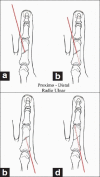Current concepts in managing fractures of metacarpal and phalangess
- PMID: 22022030
- PMCID: PMC3193632
- DOI: 10.4103/0970-0358.85341
Current concepts in managing fractures of metacarpal and phalangess
Abstract
Fractures of the metacarpal and phalanges constitute 10% of all fractures. No where in the body, the form and function are so closely related to each other than in hand. Too often these fractures are treated as minor injuries resulting in major disabilities. Diagnosis of skeletal injuries of the hand usually does not pose major problems if proper clinical examination is supplemented with appropriate radiological investigations. Proper preoperative planning, surgical intervention wherever needed at a centre with backing of equipment and implants, selection of appropriate anaesthesia and application of the principle of biological fixation, rigid enough to allow early mobilisation are all very important for a good functional outcome. This article reviews the current concepts in management of metacarpal and phalangeal fractures incorporating tips and indications for fixation of these fractures. The advantages and disadvantages of various approaches, anaesthesia, technique and mode of fixation have been discussed. The take-home message is that hand fractures are equally or more worthy of expertise as major extremity trauma are, and the final outcome depends upon the fracture personality, appropriate and timely intervention followed by proper rehabilitation. Hand being the third eye of the body, when injured it needs a multidisciplinary approach from the beginning. Though the surgeon's work appears to be of paramount importance in the early phase, the contribution from anaesthetist, physiotherapist, occupational therapist, orthotist and above all a highly motivated patient cannot be overemphasised.
Keywords: Skeletal hand trauma; metacarpal fractures; phalangeal fractures.
Conflict of interest statement
Figures









References
-
- Emmett JE, Breck LW. A review of analysis of 11,000 fractures seen in a private practice of orthopaedic surgery 1937-1956. J Bone Joint Surg Am. 1958;40:1169–75. - PubMed
-
- Lane CS. Detecting occult fractures of the metacarpal head: The Brewerton view. J Hand Surg. 1977;2:131–3. - PubMed
-
- Eyres KS, Allen TR. Skyline view of the metacarpal head in the assessment of human fight-bite injuries. J Hand Surg Br. 1993;18:43–4. - PubMed
-
- Lane CS, Kennedy JF, Kuschner SH. The reverse oblique x-ray film: Metacarpal fractures revealed. J Hand Surg Am. 1992;17:504–6. - PubMed
-
- Swanson AB. Fractures involving the digits of the hand. Orthop Clin North Am. 1970;1:261–74. - PubMed
LinkOut - more resources
Full Text Sources

